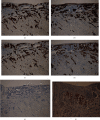Rare Anal Canal Cancer with Secondary Extramammary Paget's Disease (Pagetoid Spread) Complicated by Squamous Cell Carcinoma of the Skin
- PMID: 34381623
- PMCID: PMC8352713
- DOI: 10.1155/2021/9944886
Rare Anal Canal Cancer with Secondary Extramammary Paget's Disease (Pagetoid Spread) Complicated by Squamous Cell Carcinoma of the Skin
Abstract
A 91-year-old man had a node and erythema in the anal area resistant to treatment. A biopsy of the node in the anus showed atypical cells developing as Paget's disease, and staining revealed that the cells were CK7-positive, CK20-positive, and GCDFP15-negative. Therefore, tumor invasion with pagetoid spread (PS) from the anus to the skin was suspected, and the patient was referred to our department for a close examination and surgical treatment. Lower gastrointestinal endoscopy showed edematous, hemorrhagic mucosa in the anal canal, and he was diagnosed with adenocarcinoma via a biopsy. Additionally, redness and swelling with white moss were observed on the skin around the anus. Biopsy showed that Paget cells were diffusely present in the epithelium, and an image of squamous cell carcinoma directly under the epithelium was obtained. Taken together, the patient was diagnosed with the invasion of anal canal cancer with PS to the skin, and we performed laparoscopic abdominoperineal resection and skin carcinoma resection in the perineum. The histopathological analysis showed adenocarcinoma invading the external anal sphincter and subcutaneous adipose tissue in the vicinity of the pectinate line of the anal canal. Pagetoid spread of the adenocarcinoma was observed in the epidermis, and the open portion was slightly invaded up to the rectal mucosa. The anal skin region of the adenocarcinoma partially continued to the hair follicles, and it was complicated by squamous cell carcinoma invading the dermis. There are a few reports of anal canal cancer with PS, and the coexistence of adenocarcinoma and squamous cell carcinoma, as seen in the present case, is rare. We report our case together with relevant literature.
Copyright © 2021 Tatsuki Kusuhara et al.
Conflict of interest statement
The authors declare that there is no conflict of interest regarding the publication of this article.
Figures






References
-
- Paget J. On disease of the mammary areola preceding cancer of the mammary gland. St. Bartholowmew. Hospital Reports. 1874;10:87–89.
Publication types
LinkOut - more resources
Full Text Sources
Research Materials

